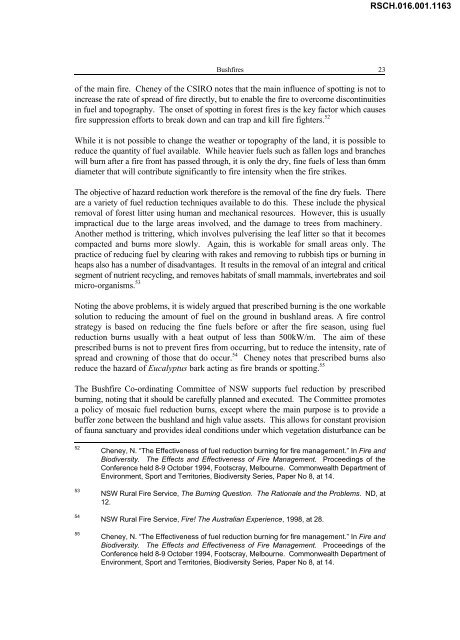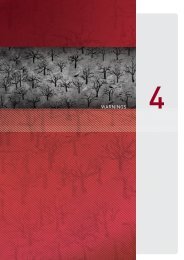RSCH.016.001.1136 - 2009 Victorian Bushfires Royal Commission
RSCH.016.001.1136 - 2009 Victorian Bushfires Royal Commission
RSCH.016.001.1136 - 2009 Victorian Bushfires Royal Commission
Create successful ePaper yourself
Turn your PDF publications into a flip-book with our unique Google optimized e-Paper software.
RSCH.016.001.1163<br />
<strong>Bushfires</strong> 23<br />
of the main fire. Cheney of the CSIRO notes that the main influence of spotting is not to<br />
increase the rate of spread of fire directly, but to enable the fire to overcome discontinuities<br />
in fuel and topography. The onset of spotting in forest fires is the key factor which causes<br />
fire suppression efforts to break down and can trap and kill fire fighters. 52<br />
While it is not possible to change the weather or topography of the land, it is possible to<br />
reduce the quantity of fuel available. While heavier fuels such as fallen logs and branches<br />
will burn after a fire front has passed through, it is only the dry, fine fuels of less than 6mm<br />
diameter that will contribute significantly to fire intensity when the fire strikes.<br />
The objective of hazard reduction work therefore is the removal of the fine dry fuels. There<br />
are a variety of fuel reduction techniques available to do this. These include the physical<br />
removal of forest litter using human and mechanical resources. However, this is usually<br />
impractical due to the large areas involved, and the damage to trees from machinery.<br />
Another method is trittering, which involves pulverising the leaf litter so that it becomes<br />
compacted and burns more slowly. Again, this is workable for small areas only. The<br />
practice of reducing fuel by clearing with rakes and removing to rubbish tips or burning in<br />
heaps also has a number of disadvantages. It results in the removal of an integral and critical<br />
segment of nutrient recycling, and removes habitats of small mammals, invertebrates and soil<br />
micro-organisms. 53<br />
Noting the above problems, it is widely argued that prescribed burning is the one workable<br />
solution to reducing the amount of fuel on the ground in bushland areas. A fire control<br />
strategy is based on reducing the fine fuels before or after the fire season, using fuel<br />
reduction burns usually with a heat output of less than 500kW/m. The aim of these<br />
prescribed burns is not to prevent fires from occurring, but to reduce the intensity, rate of<br />
spread and crowning of those that do occur. 54 Cheney notes that prescribed burns also<br />
reduce the hazard of Eucalyptus bark acting as fire brands or spotting. 55<br />
The Bushfire Co-ordinating Committee of NSW supports fuel reduction by prescribed<br />
burning, noting that it should be carefully planned and executed. The Committee promotes<br />
a policy of mosaic fuel reduction burns, except where the main purpose is to provide a<br />
buffer zone between the bushland and high value assets. This allows for constant provision<br />
of fauna sanctuary and provides ideal conditions under which vegetation disturbance can be<br />
52<br />
53<br />
54<br />
55<br />
Cheney, N. “The Effectiveness of fuel reduction burning for fire management.” In Fire and<br />
Biodiversity. The Effects and Effectiveness of Fire Management. Proceedings of the<br />
Conference held 8-9 October 1994, Footscray, Melbourne. Commonwealth Department of<br />
Environment, Sport and Territories, Biodiversity Series, Paper No 8, at 14.<br />
NSW Rural Fire Service, The Burning Question. The Rationale and the Problems. ND, at<br />
12.<br />
NSW Rural Fire Service, Fire! The Australian Experience, 1998, at 28.<br />
Cheney, N. “The Effectiveness of fuel reduction burning for fire management.” In Fire and<br />
Biodiversity. The Effects and Effectiveness of Fire Management. Proceedings of the<br />
Conference held 8-9 October 1994, Footscray, Melbourne. Commonwealth Department of<br />
Environment, Sport and Territories, Biodiversity Series, Paper No 8, at 14.
















